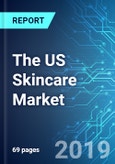Scope of the Report
The report titled “The US Skincare Market: Size, Trends & Forecasts (2019-2023)”, provides an in-depth analysis of the US Skincare market by value, by volume, by products, by segments and by distribution channels and includes product analysis as well.
The report also assesses the key opportunities in the market and outlines the factors that are and will be driving the growth of the industry. Growth of the overall US Skincare market has also been forecasted for the period 2019-2023, taking into consideration the previous growth patterns, the growth drivers and the current and future trends.
The major players dominating the US Skincare market are Estee Lauder Companies Inc., Johnson & Johnson, L’Oreal and The Procter & Gamble. The four companies have been profiled in the report providing their business overview, financial overview and business strategies.
Company Coverage
- Estee Lauder Companies Inc.
- Johnson & Johnson
- L’Oreal SA
- The Procter & Gamble Co.
Table of Contents
Executive Summary
Skin is the largest organ of the body. An individuals skin helps in regulating the body temperature. Skin also acts as a protective barrier and can be easily damaged by the outside elements. It is affected by many factors, such as exposure to UV (Ultra-violet) radiation, exposure to sun, aging, etc. Because of these reasons, a good care of skin is very essential. Skincare refers to the term involving all the things people do to keep their skin clean, healthy-looking, and attractive. Skincare also involves the practices that enhance the appearance of an individual by cleaning of dirt particles and dead cells, and support skin integrity. Skincare also makes the skin well-hydrated, without excessive moisture or dryness.
On the basis of product type, skincare industry can be broadly categorized into five types: facial care (face cream, skin-whitening products, anti-aging products, anti-acne products, sunscreen lotions & others), body care (body lotion, mass body care lotion & premium body care lotion), make-up remover, hand care and depilatories.
On the basis of distribution channel, the skincare industry include health and beauty stores, hypermarkets and supermarkets, parapharmacies/drugstores, department stores and others.
The US Skincare market has increased at a significant CAGR during the years 2014-2018 and projections are made that the market would rise in the next four years i.e. 2019-2023 tremendously. The US Skincare market is expected to increase due to growing millennial population and retail spending, rising per capita disposable income, aging population, increasing female population etc. Yet the market faces some challenges such as products involving harmful chemicals and counterfeit skincare products.
Companies Mentioned
- Estee Lauder Companies Inc.
- Johnson & Johnson
- L’Oreal SA
- The Procter & Gamble Co.








